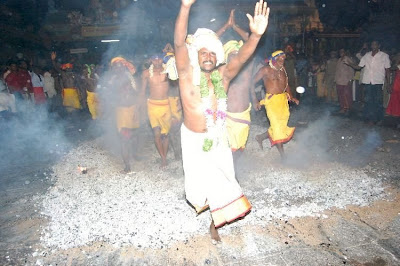Aadi Pooram Brahmotsavam is currently being observed at Arunachaleswarar Temple and Sakthi Temples at Arunachala. The Festival started on 27th July, 2016 and will culminate on Friday, August 5th, 2016.
As can be viewed in the below programme, at Arunachaleswar Temple everyday in the morning and evening, Lord Ganesha and the Divine Mother are coming out in procession during the days of this Festival.
 |
| Programme for Festival |
Adi Pooram Brahmotsavam is celebrated in all Hindu temples in Southern India in the month of Adi, which corresponds to the English months of July-August, when the asterism Pooram (Delta Leonis) is in the ascendancy. It is observed to propitiate the Sakti Goddess who is said to have come into the world on this occasion to bless all. She is thus worshipped in order that one may secure happiness for oneself and for loved ones.
Aadi Pooram is also dedicated to the birth of Goddess Andal, who is believed to be an incarnation of Goddess Lakshmi. Pooram or Puram is one among the 27 Nakshatras in Hindu Astrology.
The climax of Aadi Pooram Brahmotsavam at the Big Temple, will be celebrated on August 5th, 2016. The schedule for that day will be approximatelty as follows:
5.00 a.m. Amman Abhishekam
6.00 a.m. Alangaram
6.30 a.m. Flag Hoisting at Mother’s Shrine
8.00 a.m. Amman from Sannadhi to Vallaikappu (bangle) Mandapam
4.00 p.m. Amman in Vallaikappu and the worship of Amman by ladies
4.00 p.m. Abhishekam
6.00 p.m. Valaikappu (bangle)
8.00 p.m. Amman goes around the Temple and returns to Vallaikappu Mandapam
12.00 p.m. Adi Pooram firewalking preparation
1.30 p.m. Fire walking
 |
| Fire walk at Temple in a previous year |
Fire or Agni is the fourth element of the Panchabhutas. The essential character of Fire is to generate heat and according to Hindu Mythology, Agni is one of the Eight Guardians that guard our Universe and are known as Asta-dik-palakas.
In Indian mythology there are mentions of various types of fires. The four important ones are fire of the earth, fire of the sky, fire of the stomach (can mean hunger and digestive power as well) and the fire we commonly use.
There is a wealth of mythology attached to Arunachala connected to its association with fire and what is related to fire i.e. light and the sun.
One such legend is the one in which Lord Surya estranged from his wife Chayadevi visited Arunachaleswarar Temple to propitiate the Lord. A Tamil legend narrates another legend concerning Singavaram and a Temple dedicated to Sri Ranganadha. Here a king named Kandhan, after suffering a defeat, performed a fire walking ceremony in worship of Draupadi (from the Mahabharata). Draupadi, pleased with the worship, appeared before the king and promised that whoever should worship her as he had done would remain unscathed and also obtain whatever they prayed for. From that day onwards the fire-walking festival is observed with great enthusiasm in Tamil Nadu.
 |
| Walk will be performed by approved devotees: front of Mother's Shrine |
A special association of Arunachala as Agni Kshetra, is that of fire walking which will be observed this year on the late night of Aadi Pooram i.e. 5th August, 2016. The festival is called Theemithi Utsavam in Tamil Nadu. On the night of this Festival, devotees will walk on burning embers. This is not observed at Arunachaleswarar Temple as per agamic rules. On the night of Aadi Pooram (Pushya) star, the function will be observed immediately in front of the Unnamulai Shrine, 3rd Prakaram of Arunachaleswarar Temple.
*****************************
Sri Rajarajeshwari Temple on Girivalam Roadway, will be holding a bangle ceremony on August 5th, 2016, at their Temple followed by puja and worship of the Goddess dressed in her most resplendent best. For darshan of this Divine Goddess and to avoid crowds, you can visit the Temple after 8 p.m. on Friday, 5th August, 2016.
 |
| Sri Rajarajeshwari on a previous Aadi Pooram |
 |
| She will be the most beautifully adorned and adored Goddess at Arunachala |































